Analysis of Contract and Tort Law in Business Scenarios
VerifiedAdded on 2019/12/03
|16
|3849
|172
Report
AI Summary
This report delves into the intricacies of contract and tort law, offering a comprehensive analysis of key legal principles. It begins with an introduction to the fundamental elements of a valid contract, including offer, acceptance, consideration, and intention, and differentiates between various contract types such as distance, written, and verbal contracts. The report then explores different forms of contractual terms, including express, implied, and exclusion clauses, and their implications. Through a case study involving a departmental store and a customer named Mary, the report applies these concepts to a real-world scenario, assessing the validity of the contract, the applicability of contractual terms, and the remedies available to Mary. Furthermore, the report contrasts tort liability with contractual liability, examining the nature of liability in negligence and vicarious liability, with a case study of 'Film Flops'. Finally, the report applies the elements of tort and vicarious liability to the case scenario, providing a detailed analysis of the legal implications involved.
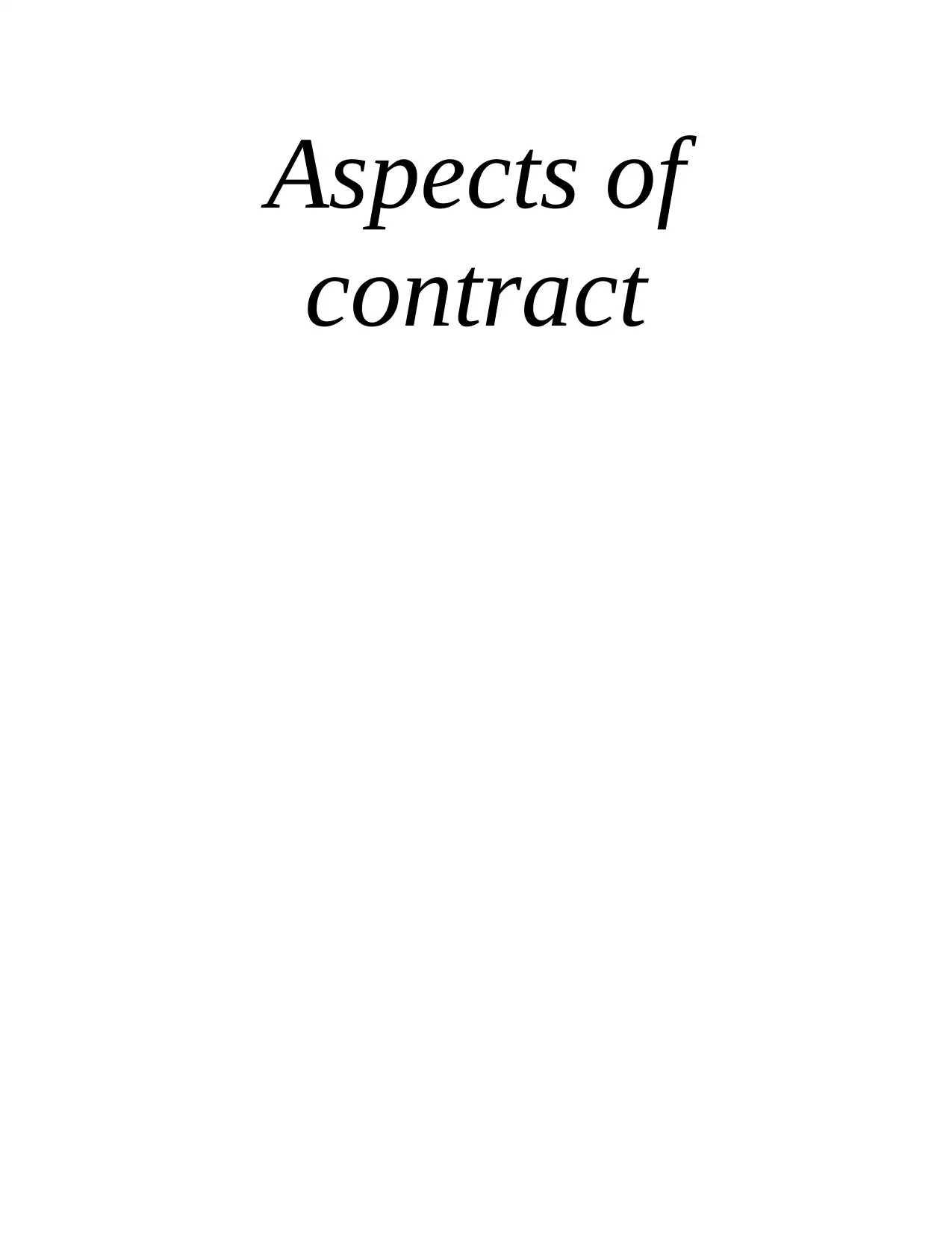
Aspects of
contract
contract
Paraphrase This Document
Need a fresh take? Get an instant paraphrase of this document with our AI Paraphraser
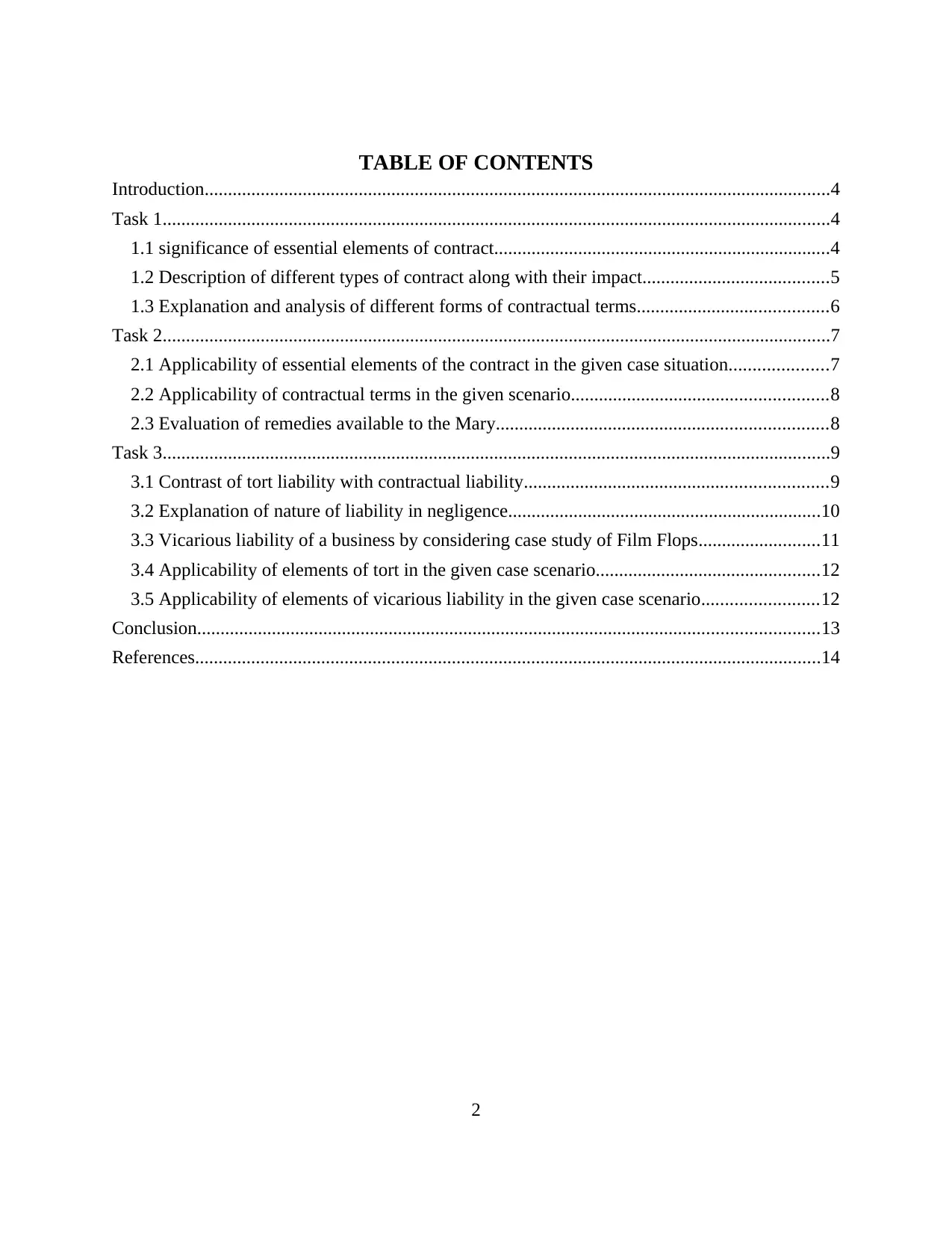
TABLE OF CONTENTS
Introduction......................................................................................................................................4
Task 1...............................................................................................................................................4
1.1 significance of essential elements of contract........................................................................4
1.2 Description of different types of contract along with their impact........................................5
1.3 Explanation and analysis of different forms of contractual terms.........................................6
Task 2...............................................................................................................................................7
2.1 Applicability of essential elements of the contract in the given case situation.....................7
2.2 Applicability of contractual terms in the given scenario.......................................................8
2.3 Evaluation of remedies available to the Mary.......................................................................8
Task 3...............................................................................................................................................9
3.1 Contrast of tort liability with contractual liability.................................................................9
3.2 Explanation of nature of liability in negligence...................................................................10
3.3 Vicarious liability of a business by considering case study of Film Flops..........................11
3.4 Applicability of elements of tort in the given case scenario................................................12
3.5 Applicability of elements of vicarious liability in the given case scenario.........................12
Conclusion.....................................................................................................................................13
References......................................................................................................................................14
2
Introduction......................................................................................................................................4
Task 1...............................................................................................................................................4
1.1 significance of essential elements of contract........................................................................4
1.2 Description of different types of contract along with their impact........................................5
1.3 Explanation and analysis of different forms of contractual terms.........................................6
Task 2...............................................................................................................................................7
2.1 Applicability of essential elements of the contract in the given case situation.....................7
2.2 Applicability of contractual terms in the given scenario.......................................................8
2.3 Evaluation of remedies available to the Mary.......................................................................8
Task 3...............................................................................................................................................9
3.1 Contrast of tort liability with contractual liability.................................................................9
3.2 Explanation of nature of liability in negligence...................................................................10
3.3 Vicarious liability of a business by considering case study of Film Flops..........................11
3.4 Applicability of elements of tort in the given case scenario................................................12
3.5 Applicability of elements of vicarious liability in the given case scenario.........................12
Conclusion.....................................................................................................................................13
References......................................................................................................................................14
2
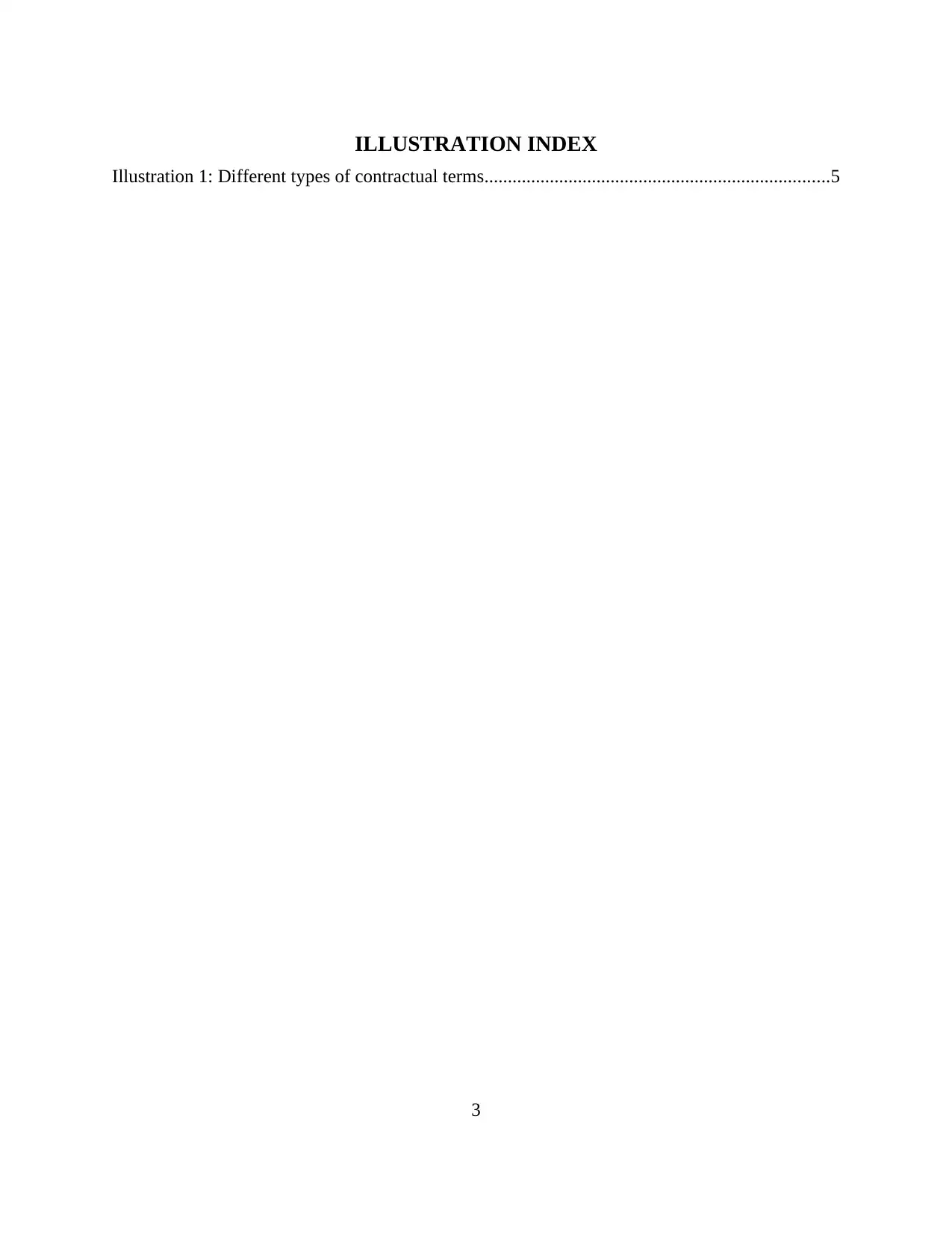
ILLUSTRATION INDEX
Illustration 1: Different types of contractual terms..........................................................................5
3
Illustration 1: Different types of contractual terms..........................................................................5
3
⊘ This is a preview!⊘
Do you want full access?
Subscribe today to unlock all pages.

Trusted by 1+ million students worldwide
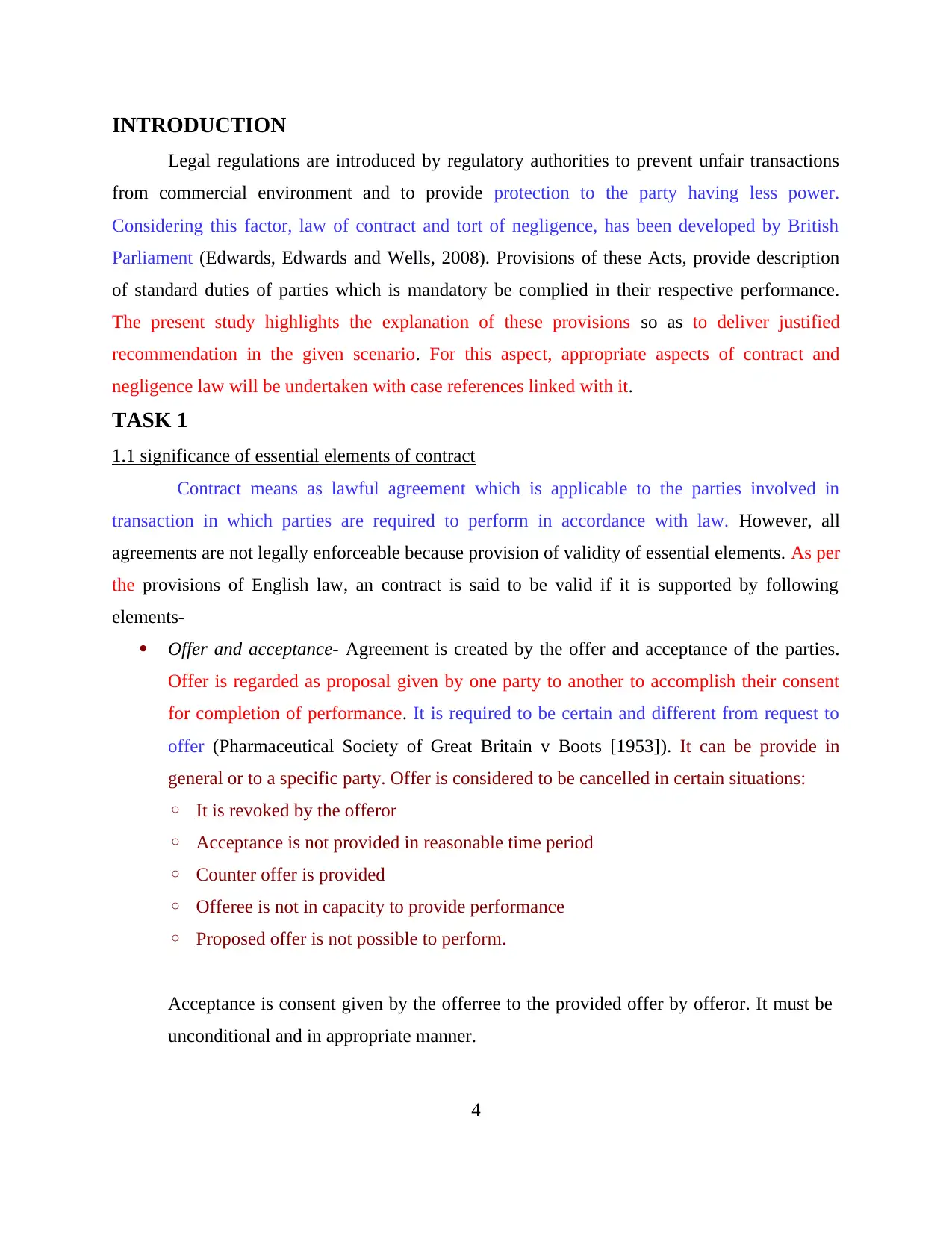
INTRODUCTION
Legal regulations are introduced by regulatory authorities to prevent unfair transactions
from commercial environment and to provide protection to the party having less power.
Considering this factor, law of contract and tort of negligence, has been developed by British
Parliament (Edwards, Edwards and Wells, 2008). Provisions of these Acts, provide description
of standard duties of parties which is mandatory be complied in their respective performance.
The present study highlights the explanation of these provisions so as to deliver justified
recommendation in the given scenario. For this aspect, appropriate aspects of contract and
negligence law will be undertaken with case references linked with it.
TASK 1
1.1 significance of essential elements of contract
Contract means as lawful agreement which is applicable to the parties involved in
transaction in which parties are required to perform in accordance with law. However, all
agreements are not legally enforceable because provision of validity of essential elements. As per
the provisions of English law, an contract is said to be valid if it is supported by following
elements-
Offer and acceptance- Agreement is created by the offer and acceptance of the parties.
Offer is regarded as proposal given by one party to another to accomplish their consent
for completion of performance. It is required to be certain and different from request to
offer (Pharmaceutical Society of Great Britain v Boots [1953]). It can be provide in
general or to a specific party. Offer is considered to be cancelled in certain situations:
◦ It is revoked by the offeror
◦ Acceptance is not provided in reasonable time period
◦ Counter offer is provided
◦ Offeree is not in capacity to provide performance
◦ Proposed offer is not possible to perform.
Acceptance is consent given by the offerree to the provided offer by offeror. It must be
unconditional and in appropriate manner.
4
Legal regulations are introduced by regulatory authorities to prevent unfair transactions
from commercial environment and to provide protection to the party having less power.
Considering this factor, law of contract and tort of negligence, has been developed by British
Parliament (Edwards, Edwards and Wells, 2008). Provisions of these Acts, provide description
of standard duties of parties which is mandatory be complied in their respective performance.
The present study highlights the explanation of these provisions so as to deliver justified
recommendation in the given scenario. For this aspect, appropriate aspects of contract and
negligence law will be undertaken with case references linked with it.
TASK 1
1.1 significance of essential elements of contract
Contract means as lawful agreement which is applicable to the parties involved in
transaction in which parties are required to perform in accordance with law. However, all
agreements are not legally enforceable because provision of validity of essential elements. As per
the provisions of English law, an contract is said to be valid if it is supported by following
elements-
Offer and acceptance- Agreement is created by the offer and acceptance of the parties.
Offer is regarded as proposal given by one party to another to accomplish their consent
for completion of performance. It is required to be certain and different from request to
offer (Pharmaceutical Society of Great Britain v Boots [1953]). It can be provide in
general or to a specific party. Offer is considered to be cancelled in certain situations:
◦ It is revoked by the offeror
◦ Acceptance is not provided in reasonable time period
◦ Counter offer is provided
◦ Offeree is not in capacity to provide performance
◦ Proposed offer is not possible to perform.
Acceptance is consent given by the offerree to the provided offer by offeror. It must be
unconditional and in appropriate manner.
4
Paraphrase This Document
Need a fresh take? Get an instant paraphrase of this document with our AI Paraphraser
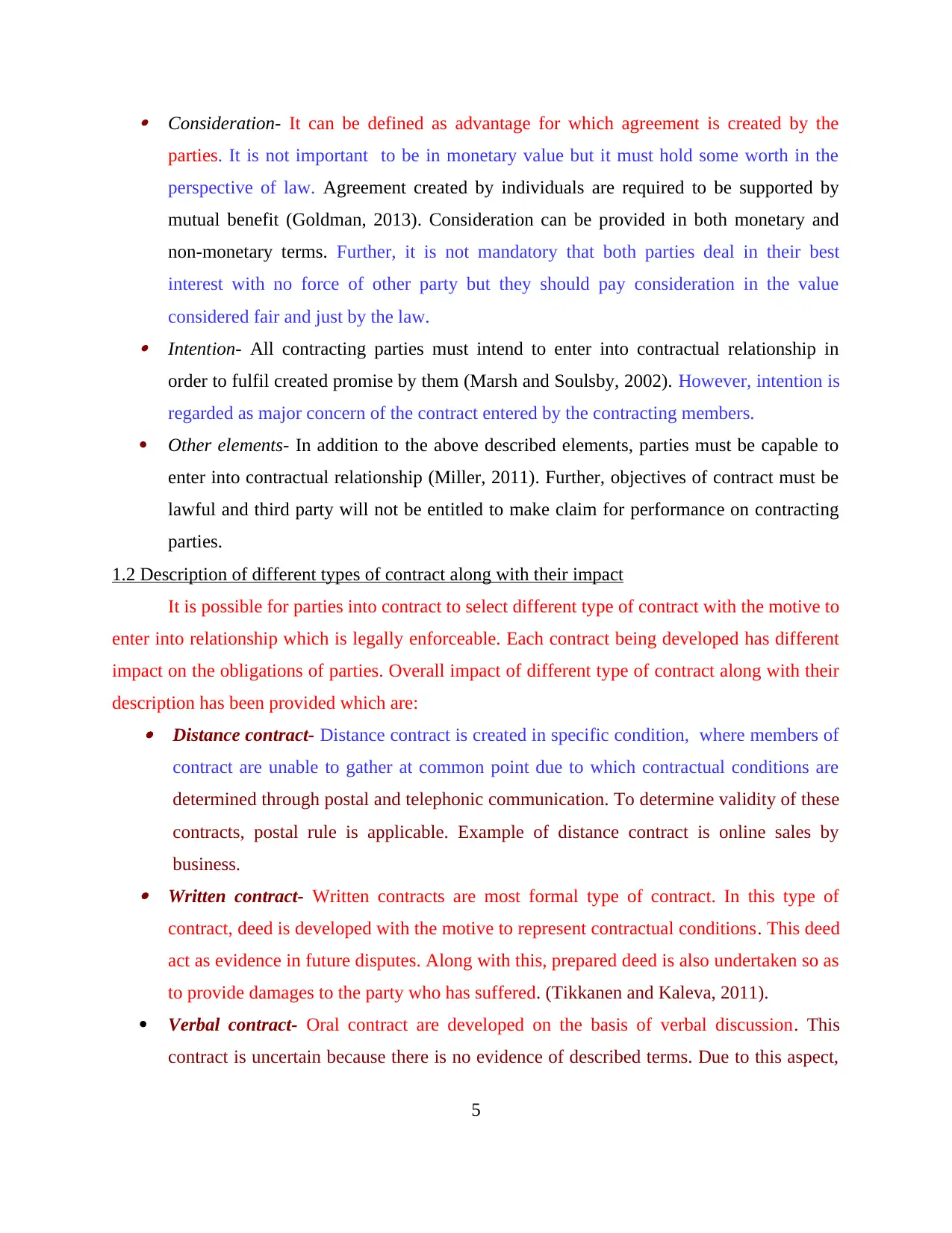
Consideration- It can be defined as advantage for which agreement is created by the
parties. It is not important to be in monetary value but it must hold some worth in the
perspective of law. Agreement created by individuals are required to be supported by
mutual benefit (Goldman, 2013). Consideration can be provided in both monetary and
non-monetary terms. Further, it is not mandatory that both parties deal in their best
interest with no force of other party but they should pay consideration in the value
considered fair and just by the law. Intention- All contracting parties must intend to enter into contractual relationship in
order to fulfil created promise by them (Marsh and Soulsby, 2002). However, intention is
regarded as major concern of the contract entered by the contracting members.
Other elements- In addition to the above described elements, parties must be capable to
enter into contractual relationship (Miller, 2011). Further, objectives of contract must be
lawful and third party will not be entitled to make claim for performance on contracting
parties.
1.2 Description of different types of contract along with their impact
It is possible for parties into contract to select different type of contract with the motive to
enter into relationship which is legally enforceable. Each contract being developed has different
impact on the obligations of parties. Overall impact of different type of contract along with their
description has been provided which are: Distance contract- Distance contract is created in specific condition, where members of
contract are unable to gather at common point due to which contractual conditions are
determined through postal and telephonic communication. To determine validity of these
contracts, postal rule is applicable. Example of distance contract is online sales by
business. Written contract- Written contracts are most formal type of contract. In this type of
contract, deed is developed with the motive to represent contractual conditions. This deed
act as evidence in future disputes. Along with this, prepared deed is also undertaken so as
to provide damages to the party who has suffered. (Tikkanen and Kaleva, 2011).
Verbal contract- Oral contract are developed on the basis of verbal discussion. This
contract is uncertain because there is no evidence of described terms. Due to this aspect,
5
parties. It is not important to be in monetary value but it must hold some worth in the
perspective of law. Agreement created by individuals are required to be supported by
mutual benefit (Goldman, 2013). Consideration can be provided in both monetary and
non-monetary terms. Further, it is not mandatory that both parties deal in their best
interest with no force of other party but they should pay consideration in the value
considered fair and just by the law. Intention- All contracting parties must intend to enter into contractual relationship in
order to fulfil created promise by them (Marsh and Soulsby, 2002). However, intention is
regarded as major concern of the contract entered by the contracting members.
Other elements- In addition to the above described elements, parties must be capable to
enter into contractual relationship (Miller, 2011). Further, objectives of contract must be
lawful and third party will not be entitled to make claim for performance on contracting
parties.
1.2 Description of different types of contract along with their impact
It is possible for parties into contract to select different type of contract with the motive to
enter into relationship which is legally enforceable. Each contract being developed has different
impact on the obligations of parties. Overall impact of different type of contract along with their
description has been provided which are: Distance contract- Distance contract is created in specific condition, where members of
contract are unable to gather at common point due to which contractual conditions are
determined through postal and telephonic communication. To determine validity of these
contracts, postal rule is applicable. Example of distance contract is online sales by
business. Written contract- Written contracts are most formal type of contract. In this type of
contract, deed is developed with the motive to represent contractual conditions. This deed
act as evidence in future disputes. Along with this, prepared deed is also undertaken so as
to provide damages to the party who has suffered. (Tikkanen and Kaleva, 2011).
Verbal contract- Oral contract are developed on the basis of verbal discussion. This
contract is uncertain because there is no evidence of described terms. Due to this aspect,
5
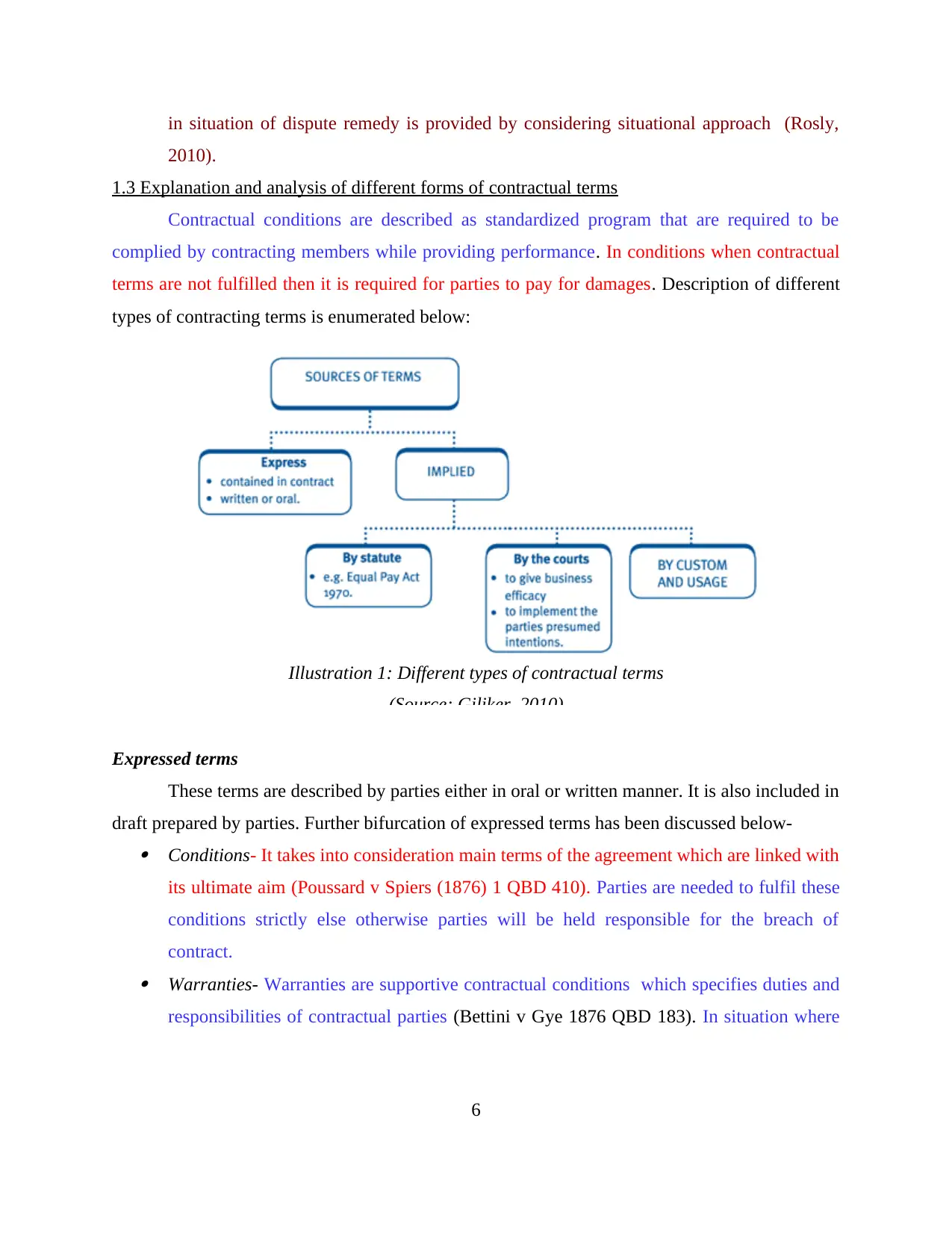
in situation of dispute remedy is provided by considering situational approach (Rosly,
2010).
1.3 Explanation and analysis of different forms of contractual terms
Contractual conditions are described as standardized program that are required to be
complied by contracting members while providing performance. In conditions when contractual
terms are not fulfilled then it is required for parties to pay for damages. Description of different
types of contracting terms is enumerated below:
Expressed terms
These terms are described by parties either in oral or written manner. It is also included in
draft prepared by parties. Further bifurcation of expressed terms has been discussed below- Conditions- It takes into consideration main terms of the agreement which are linked with
its ultimate aim (Poussard v Spiers (1876) 1 QBD 410). Parties are needed to fulfil these
conditions strictly else otherwise parties will be held responsible for the breach of
contract. Warranties- Warranties are supportive contractual conditions which specifies duties and
responsibilities of contractual parties (Bettini v Gye 1876 QBD 183). In situation where
6
Illustration 1: Different types of contractual terms
(Source: Giliker, 2010)
2010).
1.3 Explanation and analysis of different forms of contractual terms
Contractual conditions are described as standardized program that are required to be
complied by contracting members while providing performance. In conditions when contractual
terms are not fulfilled then it is required for parties to pay for damages. Description of different
types of contracting terms is enumerated below:
Expressed terms
These terms are described by parties either in oral or written manner. It is also included in
draft prepared by parties. Further bifurcation of expressed terms has been discussed below- Conditions- It takes into consideration main terms of the agreement which are linked with
its ultimate aim (Poussard v Spiers (1876) 1 QBD 410). Parties are needed to fulfil these
conditions strictly else otherwise parties will be held responsible for the breach of
contract. Warranties- Warranties are supportive contractual conditions which specifies duties and
responsibilities of contractual parties (Bettini v Gye 1876 QBD 183). In situation where
6
Illustration 1: Different types of contractual terms
(Source: Giliker, 2010)
⊘ This is a preview!⊘
Do you want full access?
Subscribe today to unlock all pages.

Trusted by 1+ million students worldwide
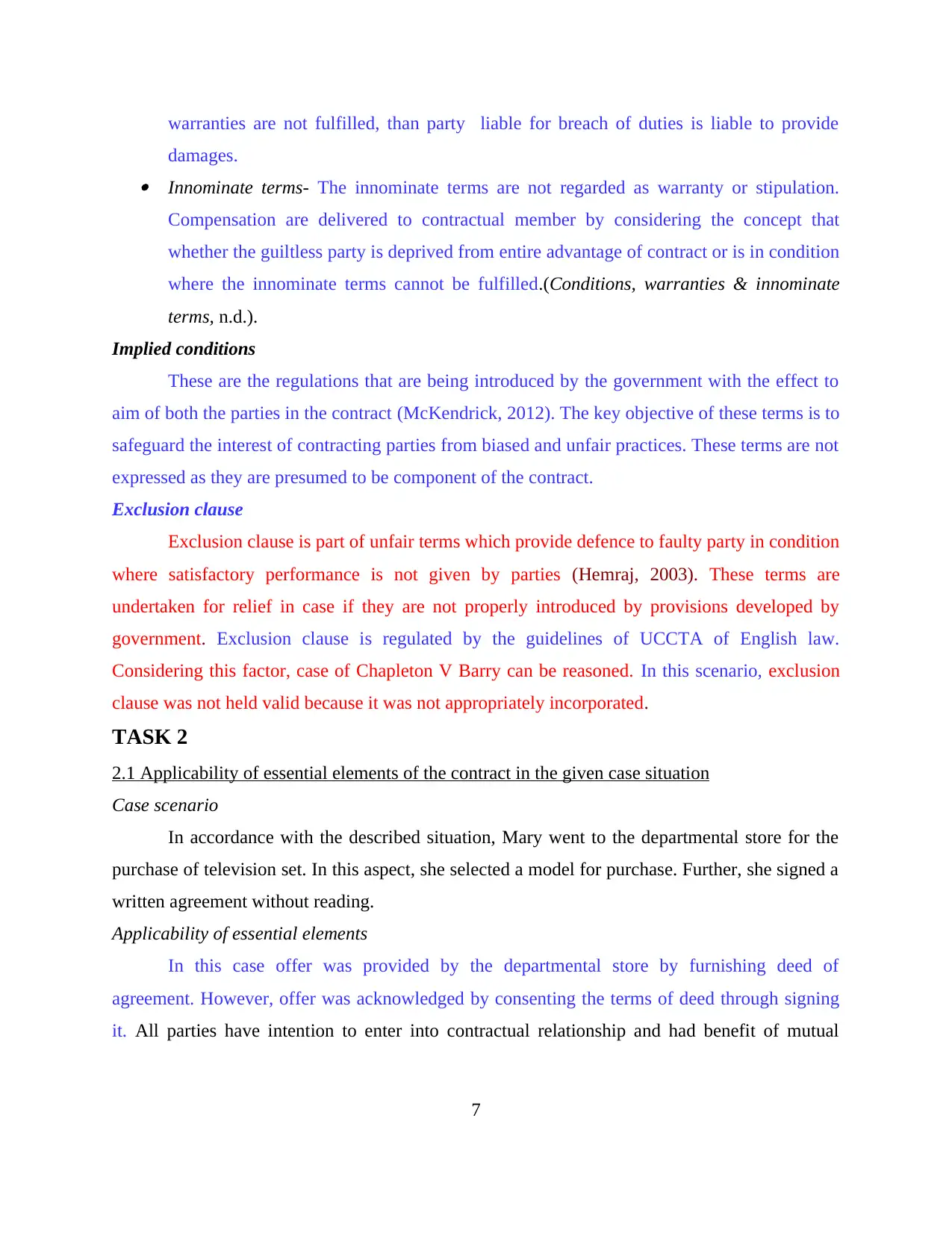
warranties are not fulfilled, than party liable for breach of duties is liable to provide
damages. Innominate terms- The innominate terms are not regarded as warranty or stipulation.
Compensation are delivered to contractual member by considering the concept that
whether the guiltless party is deprived from entire advantage of contract or is in condition
where the innominate terms cannot be fulfilled.(Conditions, warranties & innominate
terms, n.d.).
Implied conditions
These are the regulations that are being introduced by the government with the effect to
aim of both the parties in the contract (McKendrick, 2012). The key objective of these terms is to
safeguard the interest of contracting parties from biased and unfair practices. These terms are not
expressed as they are presumed to be component of the contract.
Exclusion clause
Exclusion clause is part of unfair terms which provide defence to faulty party in condition
where satisfactory performance is not given by parties (Hemraj, 2003). These terms are
undertaken for relief in case if they are not properly introduced by provisions developed by
government. Exclusion clause is regulated by the guidelines of UCCTA of English law.
Considering this factor, case of Chapleton V Barry can be reasoned. In this scenario, exclusion
clause was not held valid because it was not appropriately incorporated.
TASK 2
2.1 Applicability of essential elements of the contract in the given case situation
Case scenario
In accordance with the described situation, Mary went to the departmental store for the
purchase of television set. In this aspect, she selected a model for purchase. Further, she signed a
written agreement without reading.
Applicability of essential elements
In this case offer was provided by the departmental store by furnishing deed of
agreement. However, offer was acknowledged by consenting the terms of deed through signing
it. All parties have intention to enter into contractual relationship and had benefit of mutual
7
damages. Innominate terms- The innominate terms are not regarded as warranty or stipulation.
Compensation are delivered to contractual member by considering the concept that
whether the guiltless party is deprived from entire advantage of contract or is in condition
where the innominate terms cannot be fulfilled.(Conditions, warranties & innominate
terms, n.d.).
Implied conditions
These are the regulations that are being introduced by the government with the effect to
aim of both the parties in the contract (McKendrick, 2012). The key objective of these terms is to
safeguard the interest of contracting parties from biased and unfair practices. These terms are not
expressed as they are presumed to be component of the contract.
Exclusion clause
Exclusion clause is part of unfair terms which provide defence to faulty party in condition
where satisfactory performance is not given by parties (Hemraj, 2003). These terms are
undertaken for relief in case if they are not properly introduced by provisions developed by
government. Exclusion clause is regulated by the guidelines of UCCTA of English law.
Considering this factor, case of Chapleton V Barry can be reasoned. In this scenario, exclusion
clause was not held valid because it was not appropriately incorporated.
TASK 2
2.1 Applicability of essential elements of the contract in the given case situation
Case scenario
In accordance with the described situation, Mary went to the departmental store for the
purchase of television set. In this aspect, she selected a model for purchase. Further, she signed a
written agreement without reading.
Applicability of essential elements
In this case offer was provided by the departmental store by furnishing deed of
agreement. However, offer was acknowledged by consenting the terms of deed through signing
it. All parties have intention to enter into contractual relationship and had benefit of mutual
7
Paraphrase This Document
Need a fresh take? Get an instant paraphrase of this document with our AI Paraphraser
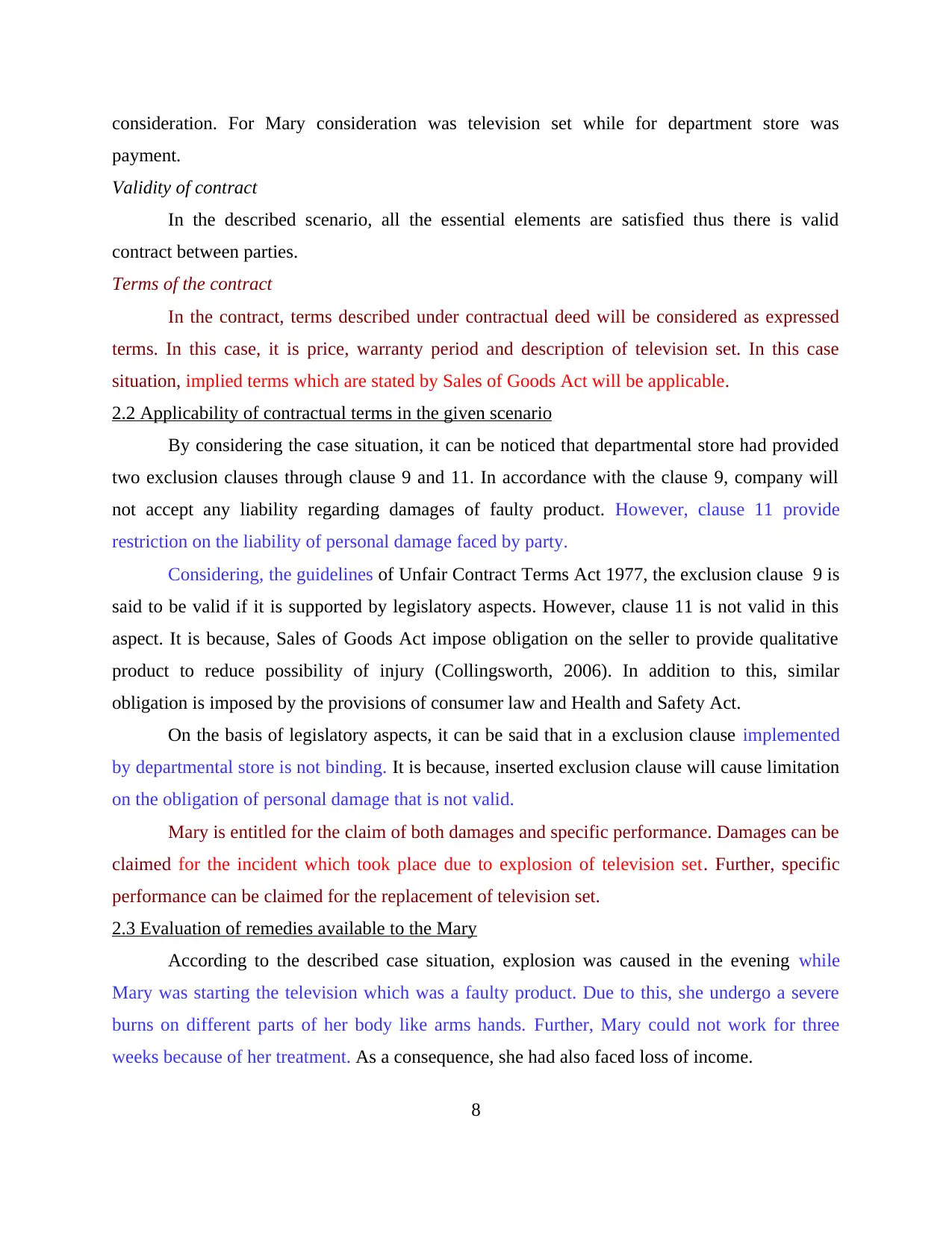
consideration. For Mary consideration was television set while for department store was
payment.
Validity of contract
In the described scenario, all the essential elements are satisfied thus there is valid
contract between parties.
Terms of the contract
In the contract, terms described under contractual deed will be considered as expressed
terms. In this case, it is price, warranty period and description of television set. In this case
situation, implied terms which are stated by Sales of Goods Act will be applicable.
2.2 Applicability of contractual terms in the given scenario
By considering the case situation, it can be noticed that departmental store had provided
two exclusion clauses through clause 9 and 11. In accordance with the clause 9, company will
not accept any liability regarding damages of faulty product. However, clause 11 provide
restriction on the liability of personal damage faced by party.
Considering, the guidelines of Unfair Contract Terms Act 1977, the exclusion clause 9 is
said to be valid if it is supported by legislatory aspects. However, clause 11 is not valid in this
aspect. It is because, Sales of Goods Act impose obligation on the seller to provide qualitative
product to reduce possibility of injury (Collingsworth, 2006). In addition to this, similar
obligation is imposed by the provisions of consumer law and Health and Safety Act.
On the basis of legislatory aspects, it can be said that in a exclusion clause implemented
by departmental store is not binding. It is because, inserted exclusion clause will cause limitation
on the obligation of personal damage that is not valid.
Mary is entitled for the claim of both damages and specific performance. Damages can be
claimed for the incident which took place due to explosion of television set. Further, specific
performance can be claimed for the replacement of television set.
2.3 Evaluation of remedies available to the Mary
According to the described case situation, explosion was caused in the evening while
Mary was starting the television which was a faulty product. Due to this, she undergo a severe
burns on different parts of her body like arms hands. Further, Mary could not work for three
weeks because of her treatment. As a consequence, she had also faced loss of income.
8
payment.
Validity of contract
In the described scenario, all the essential elements are satisfied thus there is valid
contract between parties.
Terms of the contract
In the contract, terms described under contractual deed will be considered as expressed
terms. In this case, it is price, warranty period and description of television set. In this case
situation, implied terms which are stated by Sales of Goods Act will be applicable.
2.2 Applicability of contractual terms in the given scenario
By considering the case situation, it can be noticed that departmental store had provided
two exclusion clauses through clause 9 and 11. In accordance with the clause 9, company will
not accept any liability regarding damages of faulty product. However, clause 11 provide
restriction on the liability of personal damage faced by party.
Considering, the guidelines of Unfair Contract Terms Act 1977, the exclusion clause 9 is
said to be valid if it is supported by legislatory aspects. However, clause 11 is not valid in this
aspect. It is because, Sales of Goods Act impose obligation on the seller to provide qualitative
product to reduce possibility of injury (Collingsworth, 2006). In addition to this, similar
obligation is imposed by the provisions of consumer law and Health and Safety Act.
On the basis of legislatory aspects, it can be said that in a exclusion clause implemented
by departmental store is not binding. It is because, inserted exclusion clause will cause limitation
on the obligation of personal damage that is not valid.
Mary is entitled for the claim of both damages and specific performance. Damages can be
claimed for the incident which took place due to explosion of television set. Further, specific
performance can be claimed for the replacement of television set.
2.3 Evaluation of remedies available to the Mary
According to the described case situation, explosion was caused in the evening while
Mary was starting the television which was a faulty product. Due to this, she undergo a severe
burns on different parts of her body like arms hands. Further, Mary could not work for three
weeks because of her treatment. As a consequence, she had also faced loss of income.
8
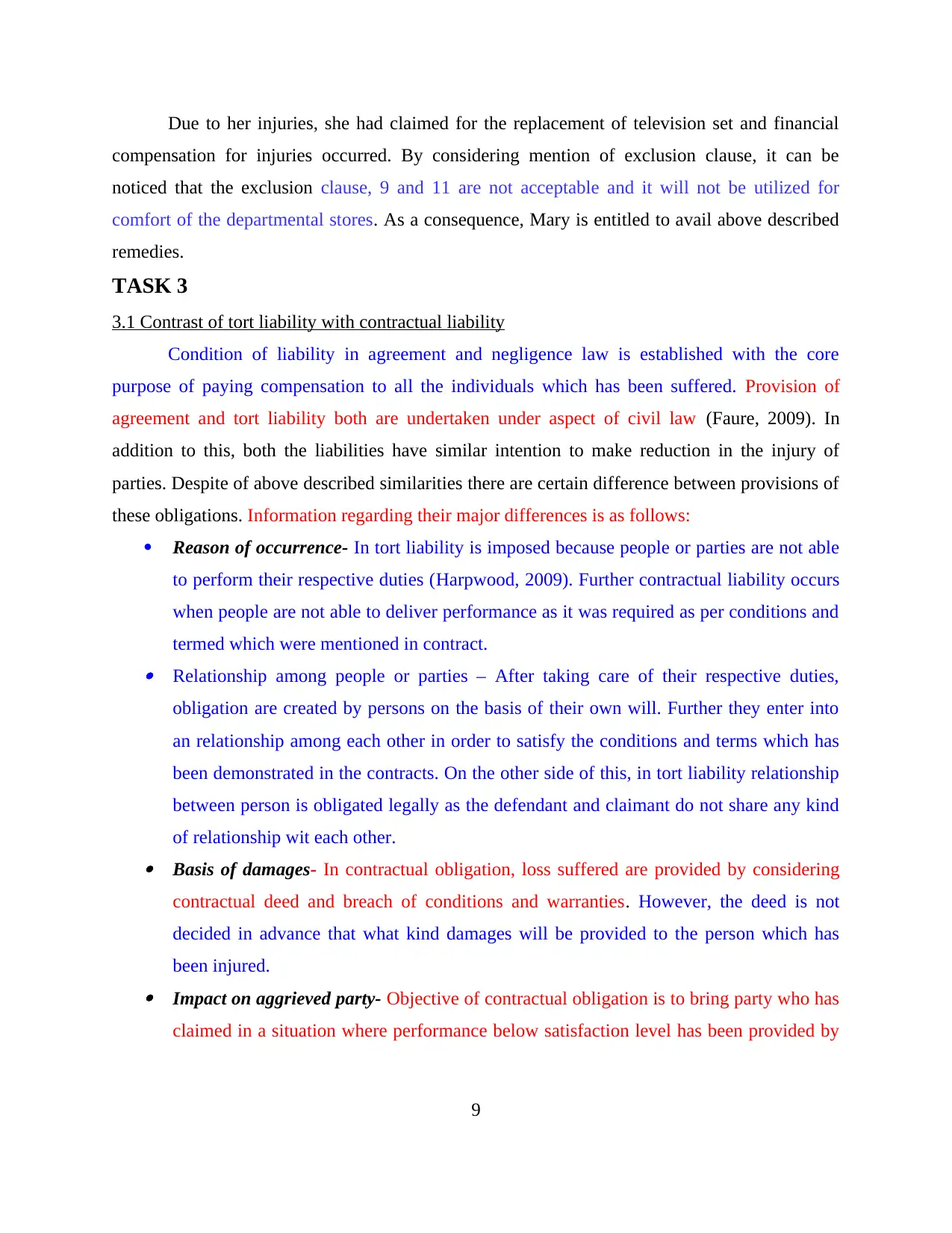
Due to her injuries, she had claimed for the replacement of television set and financial
compensation for injuries occurred. By considering mention of exclusion clause, it can be
noticed that the exclusion clause, 9 and 11 are not acceptable and it will not be utilized for
comfort of the departmental stores. As a consequence, Mary is entitled to avail above described
remedies.
TASK 3
3.1 Contrast of tort liability with contractual liability
Condition of liability in agreement and negligence law is established with the core
purpose of paying compensation to all the individuals which has been suffered. Provision of
agreement and tort liability both are undertaken under aspect of civil law (Faure, 2009). In
addition to this, both the liabilities have similar intention to make reduction in the injury of
parties. Despite of above described similarities there are certain difference between provisions of
these obligations. Information regarding their major differences is as follows:
Reason of occurrence- In tort liability is imposed because people or parties are not able
to perform their respective duties (Harpwood, 2009). Further contractual liability occurs
when people are not able to deliver performance as it was required as per conditions and
termed which were mentioned in contract. Relationship among people or parties – After taking care of their respective duties,
obligation are created by persons on the basis of their own will. Further they enter into
an relationship among each other in order to satisfy the conditions and terms which has
been demonstrated in the contracts. On the other side of this, in tort liability relationship
between person is obligated legally as the defendant and claimant do not share any kind
of relationship wit each other. Basis of damages- In contractual obligation, loss suffered are provided by considering
contractual deed and breach of conditions and warranties. However, the deed is not
decided in advance that what kind damages will be provided to the person which has
been injured. Impact on aggrieved party- Objective of contractual obligation is to bring party who has
claimed in a situation where performance below satisfaction level has been provided by
9
compensation for injuries occurred. By considering mention of exclusion clause, it can be
noticed that the exclusion clause, 9 and 11 are not acceptable and it will not be utilized for
comfort of the departmental stores. As a consequence, Mary is entitled to avail above described
remedies.
TASK 3
3.1 Contrast of tort liability with contractual liability
Condition of liability in agreement and negligence law is established with the core
purpose of paying compensation to all the individuals which has been suffered. Provision of
agreement and tort liability both are undertaken under aspect of civil law (Faure, 2009). In
addition to this, both the liabilities have similar intention to make reduction in the injury of
parties. Despite of above described similarities there are certain difference between provisions of
these obligations. Information regarding their major differences is as follows:
Reason of occurrence- In tort liability is imposed because people or parties are not able
to perform their respective duties (Harpwood, 2009). Further contractual liability occurs
when people are not able to deliver performance as it was required as per conditions and
termed which were mentioned in contract. Relationship among people or parties – After taking care of their respective duties,
obligation are created by persons on the basis of their own will. Further they enter into
an relationship among each other in order to satisfy the conditions and terms which has
been demonstrated in the contracts. On the other side of this, in tort liability relationship
between person is obligated legally as the defendant and claimant do not share any kind
of relationship wit each other. Basis of damages- In contractual obligation, loss suffered are provided by considering
contractual deed and breach of conditions and warranties. However, the deed is not
decided in advance that what kind damages will be provided to the person which has
been injured. Impact on aggrieved party- Objective of contractual obligation is to bring party who has
claimed in a situation where performance below satisfaction level has been provided by
9
⊘ This is a preview!⊘
Do you want full access?
Subscribe today to unlock all pages.

Trusted by 1+ million students worldwide
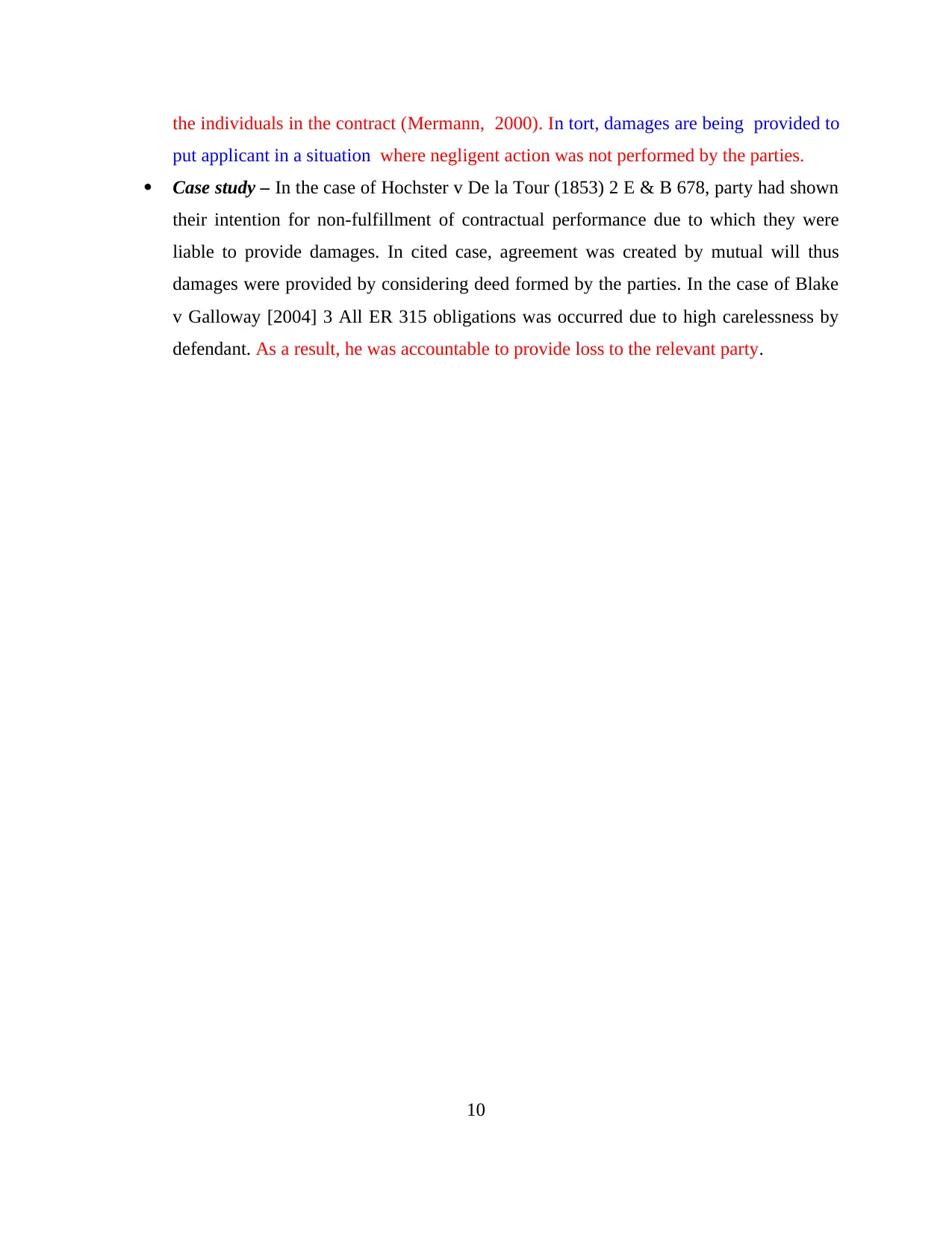
the individuals in the contract (Mermann, 2000). In tort, damages are being provided to
put applicant in a situation where negligent action was not performed by the parties.
Case study – In the case of Hochster v De la Tour (1853) 2 E & B 678, party had shown
their intention for non-fulfillment of contractual performance due to which they were
liable to provide damages. In cited case, agreement was created by mutual will thus
damages were provided by considering deed formed by the parties. In the case of Blake
v Galloway [2004] 3 All ER 315 obligations was occurred due to high carelessness by
defendant. As a result, he was accountable to provide loss to the relevant party.
10
put applicant in a situation where negligent action was not performed by the parties.
Case study – In the case of Hochster v De la Tour (1853) 2 E & B 678, party had shown
their intention for non-fulfillment of contractual performance due to which they were
liable to provide damages. In cited case, agreement was created by mutual will thus
damages were provided by considering deed formed by the parties. In the case of Blake
v Galloway [2004] 3 All ER 315 obligations was occurred due to high carelessness by
defendant. As a result, he was accountable to provide loss to the relevant party.
10
Paraphrase This Document
Need a fresh take? Get an instant paraphrase of this document with our AI Paraphraser
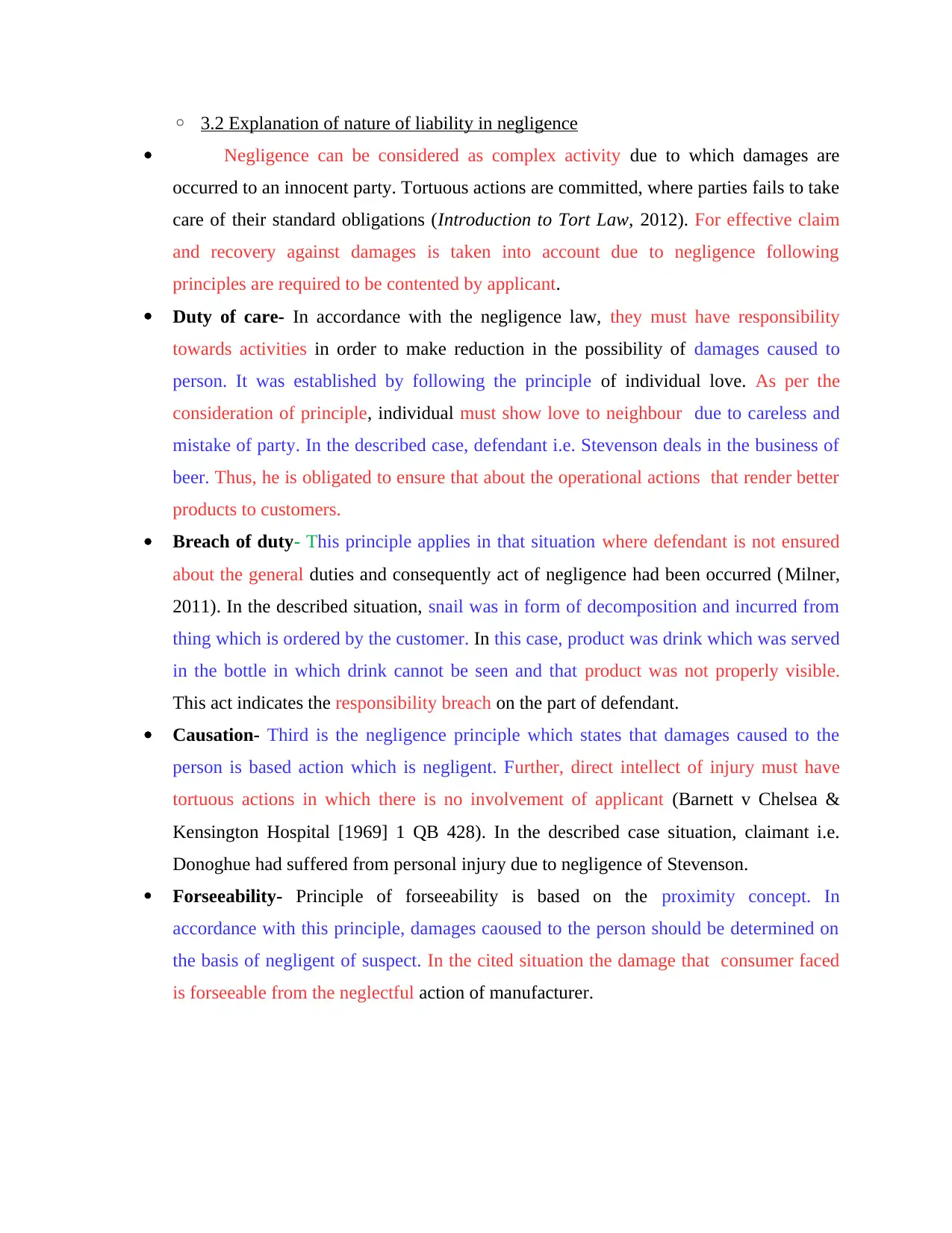
◦ 3.2 Explanation of nature of liability in negligence
Negligence can be considered as complex activity due to which damages are
occurred to an innocent party. Tortuous actions are committed, where parties fails to take
care of their standard obligations (Introduction to Tort Law, 2012). For effective claim
and recovery against damages is taken into account due to negligence following
principles are required to be contented by applicant.
Duty of care- In accordance with the negligence law, they must have responsibility
towards activities in order to make reduction in the possibility of damages caused to
person. It was established by following the principle of individual love. As per the
consideration of principle, individual must show love to neighbour due to careless and
mistake of party. In the described case, defendant i.e. Stevenson deals in the business of
beer. Thus, he is obligated to ensure that about the operational actions that render better
products to customers.
Breach of duty- This principle applies in that situation where defendant is not ensured
about the general duties and consequently act of negligence had been occurred (Milner,
2011). In the described situation, snail was in form of decomposition and incurred from
thing which is ordered by the customer. In this case, product was drink which was served
in the bottle in which drink cannot be seen and that product was not properly visible.
This act indicates the responsibility breach on the part of defendant.
Causation- Third is the negligence principle which states that damages caused to the
person is based action which is negligent. Further, direct intellect of injury must have
tortuous actions in which there is no involvement of applicant (Barnett v Chelsea &
Kensington Hospital [1969] 1 QB 428). In the described case situation, claimant i.e.
Donoghue had suffered from personal injury due to negligence of Stevenson.
Forseeability- Principle of forseeability is based on the proximity concept. In
accordance with this principle, damages caoused to the person should be determined on
the basis of negligent of suspect. In the cited situation the damage that consumer faced
is forseeable from the neglectful action of manufacturer.
Negligence can be considered as complex activity due to which damages are
occurred to an innocent party. Tortuous actions are committed, where parties fails to take
care of their standard obligations (Introduction to Tort Law, 2012). For effective claim
and recovery against damages is taken into account due to negligence following
principles are required to be contented by applicant.
Duty of care- In accordance with the negligence law, they must have responsibility
towards activities in order to make reduction in the possibility of damages caused to
person. It was established by following the principle of individual love. As per the
consideration of principle, individual must show love to neighbour due to careless and
mistake of party. In the described case, defendant i.e. Stevenson deals in the business of
beer. Thus, he is obligated to ensure that about the operational actions that render better
products to customers.
Breach of duty- This principle applies in that situation where defendant is not ensured
about the general duties and consequently act of negligence had been occurred (Milner,
2011). In the described situation, snail was in form of decomposition and incurred from
thing which is ordered by the customer. In this case, product was drink which was served
in the bottle in which drink cannot be seen and that product was not properly visible.
This act indicates the responsibility breach on the part of defendant.
Causation- Third is the negligence principle which states that damages caused to the
person is based action which is negligent. Further, direct intellect of injury must have
tortuous actions in which there is no involvement of applicant (Barnett v Chelsea &
Kensington Hospital [1969] 1 QB 428). In the described case situation, claimant i.e.
Donoghue had suffered from personal injury due to negligence of Stevenson.
Forseeability- Principle of forseeability is based on the proximity concept. In
accordance with this principle, damages caoused to the person should be determined on
the basis of negligent of suspect. In the cited situation the damage that consumer faced
is forseeable from the neglectful action of manufacturer.
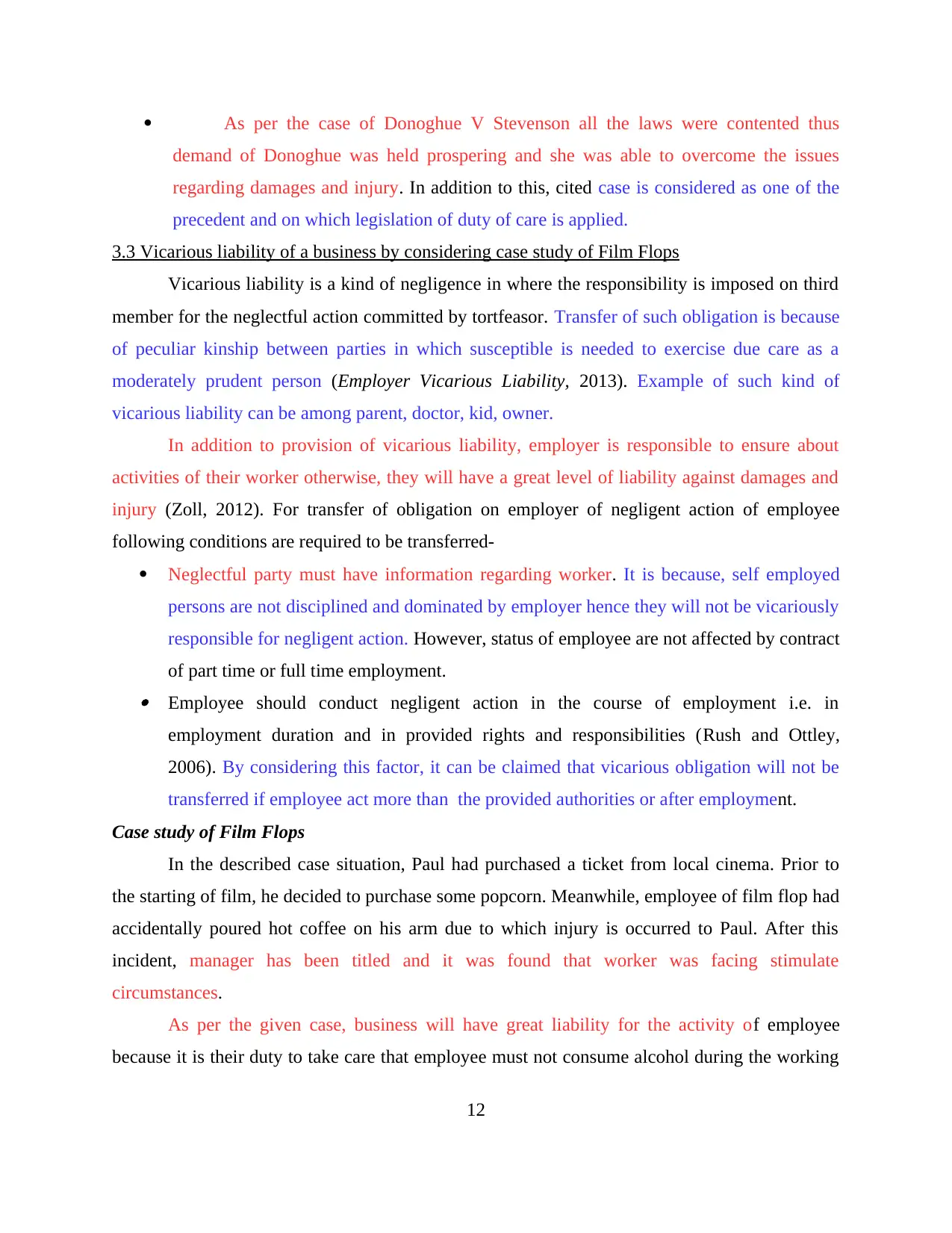
As per the case of Donoghue V Stevenson all the laws were contented thus
demand of Donoghue was held prospering and she was able to overcome the issues
regarding damages and injury. In addition to this, cited case is considered as one of the
precedent and on which legislation of duty of care is applied.
3.3 Vicarious liability of a business by considering case study of Film Flops
Vicarious liability is a kind of negligence in where the responsibility is imposed on third
member for the neglectful action committed by tortfeasor. Transfer of such obligation is because
of peculiar kinship between parties in which susceptible is needed to exercise due care as a
moderately prudent person (Employer Vicarious Liability, 2013). Example of such kind of
vicarious liability can be among parent, doctor, kid, owner.
In addition to provision of vicarious liability, employer is responsible to ensure about
activities of their worker otherwise, they will have a great level of liability against damages and
injury (Zoll, 2012). For transfer of obligation on employer of negligent action of employee
following conditions are required to be transferred-
Neglectful party must have information regarding worker. It is because, self employed
persons are not disciplined and dominated by employer hence they will not be vicariously
responsible for negligent action. However, status of employee are not affected by contract
of part time or full time employment. Employee should conduct negligent action in the course of employment i.e. in
employment duration and in provided rights and responsibilities (Rush and Ottley,
2006). By considering this factor, it can be claimed that vicarious obligation will not be
transferred if employee act more than the provided authorities or after employment.
Case study of Film Flops
In the described case situation, Paul had purchased a ticket from local cinema. Prior to
the starting of film, he decided to purchase some popcorn. Meanwhile, employee of film flop had
accidentally poured hot coffee on his arm due to which injury is occurred to Paul. After this
incident, manager has been titled and it was found that worker was facing stimulate
circumstances.
As per the given case, business will have great liability for the activity of employee
because it is their duty to take care that employee must not consume alcohol during the working
12
demand of Donoghue was held prospering and she was able to overcome the issues
regarding damages and injury. In addition to this, cited case is considered as one of the
precedent and on which legislation of duty of care is applied.
3.3 Vicarious liability of a business by considering case study of Film Flops
Vicarious liability is a kind of negligence in where the responsibility is imposed on third
member for the neglectful action committed by tortfeasor. Transfer of such obligation is because
of peculiar kinship between parties in which susceptible is needed to exercise due care as a
moderately prudent person (Employer Vicarious Liability, 2013). Example of such kind of
vicarious liability can be among parent, doctor, kid, owner.
In addition to provision of vicarious liability, employer is responsible to ensure about
activities of their worker otherwise, they will have a great level of liability against damages and
injury (Zoll, 2012). For transfer of obligation on employer of negligent action of employee
following conditions are required to be transferred-
Neglectful party must have information regarding worker. It is because, self employed
persons are not disciplined and dominated by employer hence they will not be vicariously
responsible for negligent action. However, status of employee are not affected by contract
of part time or full time employment. Employee should conduct negligent action in the course of employment i.e. in
employment duration and in provided rights and responsibilities (Rush and Ottley,
2006). By considering this factor, it can be claimed that vicarious obligation will not be
transferred if employee act more than the provided authorities or after employment.
Case study of Film Flops
In the described case situation, Paul had purchased a ticket from local cinema. Prior to
the starting of film, he decided to purchase some popcorn. Meanwhile, employee of film flop had
accidentally poured hot coffee on his arm due to which injury is occurred to Paul. After this
incident, manager has been titled and it was found that worker was facing stimulate
circumstances.
As per the given case, business will have great liability for the activity of employee
because it is their duty to take care that employee must not consume alcohol during the working
12
⊘ This is a preview!⊘
Do you want full access?
Subscribe today to unlock all pages.

Trusted by 1+ million students worldwide
1 out of 16
Related Documents
Your All-in-One AI-Powered Toolkit for Academic Success.
+13062052269
info@desklib.com
Available 24*7 on WhatsApp / Email
![[object Object]](/_next/static/media/star-bottom.7253800d.svg)
Unlock your academic potential
Copyright © 2020–2025 A2Z Services. All Rights Reserved. Developed and managed by ZUCOL.





